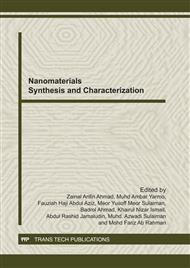p.181
p.186
p.191
p.196
p.202
p.206
p.211
p.217
p.222
Growth and Characterization of Indium Doped ZnO Nanowires Using Vapor Transport Deposition Method
Abstract:
Indium (In) doped ZnO nanowires (NWs) has been grown on silicon substrate without the use of catalyst. In conventional vapor transport deposition method, the ZnO source powder usually mixed with In dopant and placed in the middle of quartz tube. However, in this work, the graphite mixed ZnO source powder on a crucible was placed at the center of the quartz tube. While the graphite mixed In2O3 was placed at the downstream of the furnace with a distance of 1 cm from the graphite mixed ZnO powder. Morphological study has been carried out using field emission scanning electron microscopy (FESEM). The result showed that the grown NWs have uniform hexagonal nanostructures. Chemical composition has been examined by energy dispersive X-ray spectroscopy (EDS). XRD spectrum of the In doped ZnO NWs has also been taken to study the crystallinity of the structure.
Info:
Periodical:
Pages:
202-205
Citation:
Online since:
October 2011
Authors:
Keywords:
Price:
Сopyright:
© 2012 Trans Tech Publications Ltd. All Rights Reserved
Share:
Citation:


